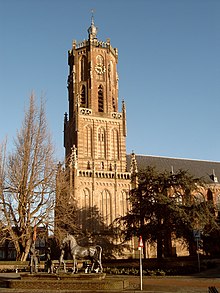Sint Maartenskerk (Elst)
The Grote of Sint Maartenskerk ( German Great or St. Martins Church ; also called Sint Werenfriduskerk ) is the Protestant parish church of Elst (municipality of Overbetuwe ) in the Dutch province of Gelderland .
history
The tradition of cult and worship at the location of the church goes back to Roman times. As part of the reconstruction of the church after it was destroyed in the Second World War, archaeological investigations below the Gothic nave uncovered the foundations of a Roman temple from around AD 50 with dimensions of 30.9 × 23.1 m.
Finds indicate that the temple itself was built over a Batavian sanctuary .
A parish church probably existed at this point from around 690. It was consecrated by St. Willibrord St. Salvator . Saint Werenfridus worked here as Willibrord's follower in the mission . During the archaeological excavations, foundations of the Salvator Church, dated to the 8th century, were found, which were enormous for the time, which suggests the importance of Elst for the Christian mission. It was a large hall church with a nave of 22 × 12 m and a retracted, just closed choir of 5 × 5 m. This church was destroyed by a Norman raid in 930.
Bishop Balderich von Utrecht arranged for the church to be rebuilt and consecrated the new building to St. Martin of Tours . At the same time the bones of Werenfridus were raised and buried in the crypt.
From 1444 the Romanesque church was replaced by a late Gothic two-nave new building. The nave has only a north aisle, significantly lower than the main nave, without the height difference being used for an upper aisle . This makes the Maartenskerk the rare case of an asymmetrical pseudo-basilica . In 1483 the church was consecrated to St. Werenfridus. But the Werenfridus shrine was destroyed in iconoclasm as early as the Reformation . To the north of the Gothic choir, parts of the Romanesque choir and the crypt below have been preserved in the sacristy. The parish belongs to the Protestant Church in the Netherlands .
organ
The history of the organs of the Sint Maartenskerk goes back to the 16th century. Today's organ was built in 1953 by the organ builder G. van Leeuwen & Sons (Leiderdorp) as a replacement for the organ built by the organ builder CGF Witte in 1869, which was destroyed in 1944.
|
|
|
|||||||||||||||||||||||||||||||||||||||||||||||||||||||||||||||||||||||||||||||||||||||||||||||||||||||||||||||||||||||||||||||||||||
- Coupling: II / I, I / P, II / P
literature
- Carel van Gestel: Van Kerk naar Kerk, Volume 1: De Betuwe , Zaltbommel 2007.
Web links
Individual evidence
- ↑ Further information on the organ (Dutch) ( Memento from November 27, 2013 in the Internet Archive )
Coordinates: 51 ° 55 ′ 11.4 " N , 5 ° 50 ′ 58.4" E


